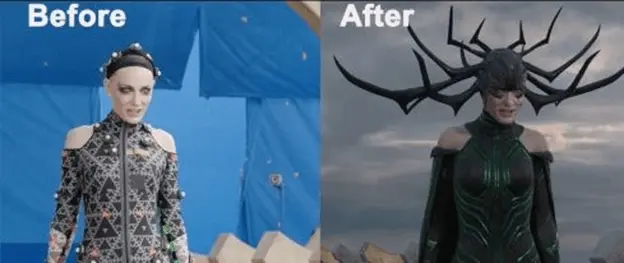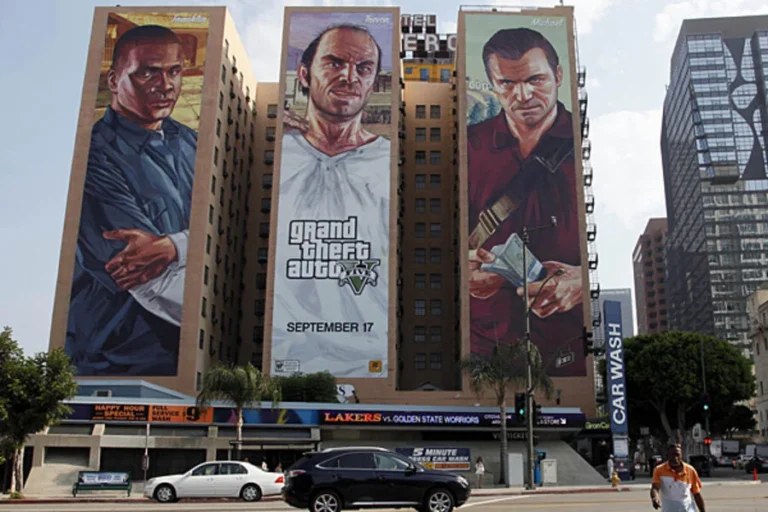Visual Effects (VFX) and Computer-Generated Imagery (CGI) have revolutionized the world of filmmaking, bringing unimaginable creations and realistic simulations to the silver screen. Understanding these two essential components of modern cinema is crucial for anyone interested in the magic behind the movies.
In this article by Polydin game art outsourcing studio, we will delve into the realm of VFX and CGI, exploring their definitions, differences, applications, and pivotal roles in shaping contemporary film production’s visual landscapes.
What is VFX?

Visual Effects (VFX) refers to the process of creating, manipulating, or enhancing visual elements in film, television, or other forms of media that cannot be achieved through conventional live-action filming. VFX encompasses a wide range of techniques and technologies, including computer-generated imagery (CGI), digital compositing, and practical effects. These techniques are used to add or alter elements in a scene, such as creatures, environments, explosions, and special effects, making the impossible appear real on screen.
VFX artists work meticulously to seamlessly integrate these elements into live-action footage, enhancing storytelling and immersing viewers in fantastical worlds. VFX has become an indispensable tool in modern filmmaking, allowing directors and creators to bring their imaginative visions to life.
Read Also: VFX in Video Games | From History to Future
What is CGI?

Computer-Generated Imagery (CGI) is a broad term encompassing the creation of visual elements, scenes, or effects using computer software and digital techniques. CGI is widely used in various forms of media, including film, television, video games, and advertising. It involves the generation of images, animations, or visual sequences that can be either entirely computer-generated or a combination of computer-generated elements and real-world footage (live-action).
CGI enables the creation of stunning and often impossible visuals, such as lifelike creatures, fantastical environments, complex simulations, and special effects that would be challenging or impossible to achieve through practical means. It has revolutionized the entertainment industry and has become an integral part of modern filmmaking and visual storytelling, allowing filmmakers and artists to realize their creative visions with unparalleled flexibility and realism.
Read Also: Exploring CGI and 3D Animation: From Concepts to Applications
Key Differences between VFX and CGI

Distinguishing between VFX and CGI is crucial in understanding the magic behind modern movie-making and visual storytelling. While these terms are often used interchangeably, they represent distinct approaches to achieving stunning on-screen visuals. This section explores the key differences that set VFX and CGI apart, shedding light on the diverse techniques and technologies filmmakers and artists employ to bring their imaginative worlds to life.
Form
VFX and CGI differ fundamentally in their forms and how they are executed in filmmaking. VFX typically involves manipulating real-world footage or objects to create seamless, often subtle, enhancements or alterations. For instance, in a sci-fi movie, VFX could make a character’s eyes glow or simulate realistic weather conditions.
In contrast, CGI relies on entirely computer-generated assets and environments. Everything, from characters and props to entire landscapes, is digitally created from scratch using 3D modeling and animation software. This form of CGI is particularly common in fantasy films like “Avatar,” where entire alien worlds are constructed digitally.
Application
VFX and CGI find applications in different contexts within the film industry. VFX often deals with improving what is already there, providing practical solutions for complex shots, such as removing wires holding actors during stunts or adding explosions to enhance action scenes. Directors turn to VFX artists to make the impossible seem real without building elaborate physical sets or props.
On the other hand, CGI is used when the desired visuals cannot be achieved practically. It’s ideal for creating fantastical creatures, otherworldly landscapes, or environments that simply don’t exist in reality. Films like “The Lord of the Rings” heavily relied on CGI to bring creatures like Gollum to life, a character who would have been extremely challenging to realize using traditional practical effects.
Software
The software used in VFX and CGI also reflects their distinctive approaches. VFX heavily involves software suites like Adobe After Effects or Autodesk Flame, which excel in compositing and enhancing existing footage. These tools empower artists to seamlessly blend real-world elements with digital effects, making them essential in post-production.
Conversely, CGI leans on powerful 3D modeling and animation software like Autodesk Maya, Blender, or Cinema 4D. These platforms enable artists to craft intricate 3D models, simulate physics, and generate photorealistic imagery. CGI studios employ dedicated teams of digital artists specializing in these applications to create entire virtual worlds.
Role in Film Production
The role of VFX and CGI in film production varies significantly. VFX is often seen as a problem solver, helping filmmakers achieve their vision without constraints. Directors can use VFX to correct continuity errors, create historically accurate backdrops, or even replace entire backgrounds in post-production. It plays a vital role in enhancing the visual quality of a film without necessarily dominating its aesthetic.
Conversely, CGI often takes a more prominent role in shaping the visual style of a film. Entire sequences and characters can be entirely computer-generated, as seen in movies like “Avatar” or “The Jungle Book.” CGI becomes an essential tool when filmmakers aim to transport audiences to fantastical realms that don’t exist in our world. The decisions regarding CGI significantly impact a film’s overall look and feel, influencing everything from character design to the intricacies of virtual physics.
Flexibility
Flexibility is a key differentiator when comparing Visual Effects VFX and CGI in filmmaking. VFX offers great flexibility, particularly when dealing with real-world footage. It allows filmmakers to make adjustments or enhancements to scenes during post-production. For example, if a shot doesn’t capture the desired weather conditions, VFX can seamlessly add rain or snow to create the intended atmosphere. This flexibility extends to scenarios where actors’ performances need adjustments, such as altering facial expressions or body movements.
In contrast, CGI provides unparalleled flexibility when it comes to creating entirely new elements. Filmmakers can envision and execute scenes that would be impossible to achieve practically. For instance, in a fantasy film like “Harry Potter,” CGI was instrumental in bringing magical creatures like Hippogriffs and Dementors to life. The flexibility of CGI allows filmmakers to push the boundaries of creativity by crafting entire worlds and characters unbounded by the constraints of reality.
Cost
Cost considerations play a substantial role in choosing between VFX and CGI. VFX is often viewed as a cost-effective solution because it typically involves working with existing footage or practical sets. Enhancements and alterations can be made without the need for extensive pre-production planning or constructing elaborate digital assets. This makes VFX an attractive choice for scenes with budget constraints.
Conversely, CGI can be considerably more expensive due to the resources required for its creation. Developing high-quality 3D models and animations demands specialized software and skilled artists. Additionally, rendering CGI sequences can be time-consuming and requires powerful hardware. Moreover, CGI often involves extensive pre-production planning and collaboration between directors, artists, and technical teams. This can result in higher initial costs.
However, the cost dynamics shift when considering the scope of the project. For films heavily reliant on CGI, like “Avatar,” the initial investment in digital assets and technology can pay off in the long run as filmmakers gain greater creative control and avoid practical limitations. Filmmakers must strike a balance between their creative vision and budget constraints when deciding between VFX and CGI.
Time
Time is a critical factor in filmmaking, and choosing between VFX and CGI can significantly impact a project’s timeline. VFX is often quicker to implement, especially when dealing with minor enhancements or corrections. Post-production teams can work on VFX shots concurrently with editing, allowing filmmakers to make necessary adjustments swiftly.
Conversely, CGI can be time-intensive. Creating detailed 3D models, rendering complex scenes, and achieving photorealism demand meticulous planning and execution. Pre-production efforts to design and model CGI elements can extend the project timeline. Additionally, rendering CGI scenes can require extensive computing time, potentially causing delays in post-production.
However, the time investment in CGI can yield stunning visual results. Films like “The Lord of the Rings” trilogy exemplify how meticulous CGI work can transform a cinematic experience. When filmmakers aim for groundbreaking visuals or otherworldly environments, the time invested in CGI can be well worth it.
What is the difference between 3D and VFX?
3D refers to the creation of three-dimensional models and environments using computer graphics. These models can be characters, objects, or entire landscapes, created from scratch and manipulated in a virtual space. 3D modeling focuses on geometry, textures, lighting, and rendering to create images that appear realistic or stylized, depending on the intent. It is often used in video games, animation, architecture, and simulations.
VFX (Visual Effects), on the other hand, involves the integration of computer-generated imagery (CGI) with live-action footage. VFX artists use techniques like compositing, digital manipulation, and computer graphics to enhance or alter filmed scenes, creating effects that would be impossible or too expensive to achieve practically. VFX is typically used in film, TV shows, and commercials to create environments, characters, or effects that blend seamlessly with real-world footage.
Key difference: 3D focuses on creating objects or environments digitally from the ground up, while VFX focuses on merging those digital elements with live-action footage to create an integrated and realistic final product.
Best CGI Effects in Video Games
Video game CGI has reached cinematic levels in recent years, blurring the line between gameplay and film. But what makes a CGI moment truly unforgettable? It’s not just high resolution or realistic models—it’s how those visuals serve the experience. Some of the best CGI in gaming history doesn’t just look good; it sticks with you emotionally.
Games like The Last of Us Part II and God of War: Ragnarök use CGI to create expressive character performances, lifelike environments, and seamless cinematic transitions. Meanwhile, Final Fantasy XVI delivers spectacular fantasy sequences that rival Hollywood blockbusters. Even indie titles like Hellblade: Senua’s Sacrifice push boundaries, blending motion capture with digital effects to create emotionally intense experiences.
The best CGI enhances immersion and storytelling. It can make you feel awe, dread, wonder, or all three in the same moment. In this sense, CGI in games is more than just visuals. It’s worldbuilding in motion.
Common Types of Visual Effects in Games
Particle Effects
Think sparks, smoke, dust, fire, rain, and explosions. Particle systems allow artists to simulate massive quantities of small elements in motion. Games like Control and Returnal use particle effects to create surreal, dynamic environments where even destruction looks like choreography. When done right, particles can make the world feel alive; even volatile.
Shaders
Shaders are programs that tell a game engine how surfaces should look under different lighting and conditions. They bring materials to life. whether it’s sweaty skin, wet pavement, or translucent alien goo. The Last of Us Part II uses complex shaders to enhance realism, from subtle facial pores to the shine of rain on metal.
Lighting
Lighting is arguably the most transformative visual effect. Ray tracing, in particular, has been a game-changer, allowing for real-time reflections and shadows that respond naturally to the environment. Games like Cyberpunk 2077 and Alan Wake 2 use lighting not just for aesthetics, but to guide players and build atmosphere.
Physics-Based Effects
These effects make the world react believably: cloth fluttering, liquids sloshing, debris bouncing. In Red Dead Redemption 2, for example, snow deforms underfoot and clothes cling realistically when wet. These tiny details make the world feel tangible and reactive, not just scripted.
Does Marvel use CGI or VFX?
Marvel uses both CGI (Computer-Generated Imagery) and VFX (Visual Effects) in their films. CGI is employed to create fully digital characters like Hulk, Thanos, and Spider-Man’s suits. These are animated and rendered in a 3D environment.
VFX is used to combine these CGI elements with live-action scenes. For instance, in movies like Avengers: Endgame, digital environments like battlefields or cities are composited with actors filmed on green screens, creating a final shot that appears as though everything is happening in the same space. VFX also involves enhancing practical effects with digital fire, explosions, or other environmental details to make scenes more immersive and visually impressive.
In summary, Marvel uses a combination of both CGI and VFX to bring their superhero worlds to life.
Conclusion
In summary, the differences between VFX and CGI in filmmaking are substantial and nuanced. VFX provides flexibility for enhancing real-world footage and is often a cost-effective choice for many projects. On the other hand, CGI offers unparalleled creative freedom but comes with higher initial costs and longer production timelines.
Filmmakers must carefully consider their project’s unique needs, budget constraints, and creative ambitions when deciding whether to utilize VFX, CGI or a combination of both. Ultimately, the choice between these two powerful tools hinges on achieving the desired visual impact while managing the resources available for the project.



